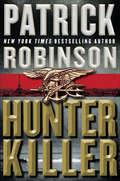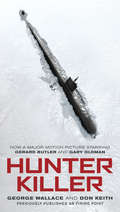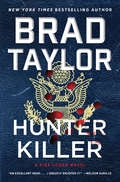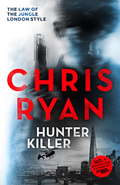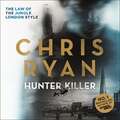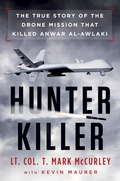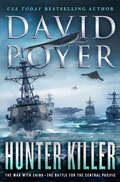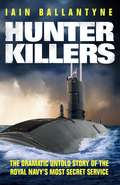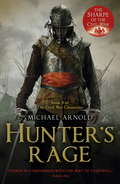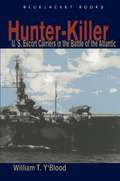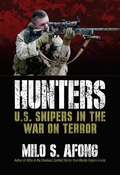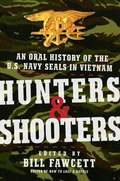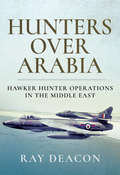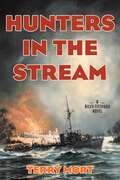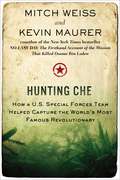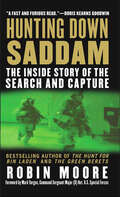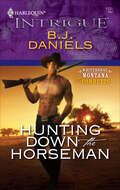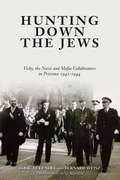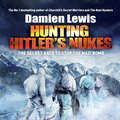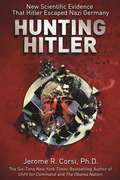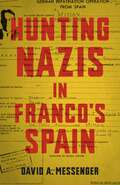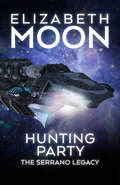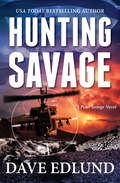- Table View
- List View
Hunter Killer (Arnold Morgan #8)
by Patrick RobinsonAmerican military forces race to prevent a coup in the Middle East in this thriller by the New York Times–bestselling author of Scimitar SL-2.Saudi Arabia, the world’s leading producer of oil, is on the brink of revolution. Inside the opulent palaces and lavish mansions, the royal family is ransacking the country’s dwindling coffers while the desert kingdom seethes with unrest. Appalled at his family’s extravagant lifestyle, Crown Prince Nasir vows to end the careless and destructive rule, and sets in motion a top-secret operation to destroy the Saudi oil industry and bankrupt the monarch. To do so, he must enlist the help of an ally, a naval power willing to help in return for a share of the wealth.Nasir turns to France, with its lethal Hunter Killer submarines, capable of inflicting devastating damage on the massive oil installations along the shores of the Red Sea and in the Persian Gulf. Objective: To shift the power structure of the world’s oil giant.Under the command of the mysterious and lethally effective Colonel Jacques Gamoudi—nicknamed “Le Chasseur,” or “The Hunter—the ferocious battle for the desert kingdom begins. As the world’s oil markets plunge into chaos, United States Admiral Arnold Morgan, former Security Adviser to the President, and Lieutenant Commander Jimmy Ramshawe are summonded to the White House, where they learn that Gamoudi has been joined by none other than Morgan’s archenemy, Hamas General Ravi Rashood, in the battle for the capital city of Riyadh.Now Le Chasseur becomes the hunted, by both French and American Special Forces—one trying to assassinate and silence him forever, the other desperate to take him alive and to force a public confession of France’s subversive actions.Praise for Patrick Robinson“An absolutely marvelous thriller writer.” —Jack Higgins“The new Frederick Forsyth.” —Guardian“Patrick Robinson is quickly replacing Tom Clancy as the preeminent writer of modern naval fiction.” —Florida Times-Union“One of the crown princes of the beach read-thriller.” —Stephen Coonts
Hunter Killer (Movie Tie-In)
by Don Keith George WallaceNOW A MAJOR MOTION PICTURE STARRING GERARD BUTLER AND GARY OLDMANA submarine captain races to prevent World War III in this thrilling adventure.Below the polar ice cap, an American nuclear submarine moves quietly in the freezing water, tailing a new Russian sub. But the usual, unspoken game of hide-and-seek between opposing captains is ended when the Americans hear sounds of disaster and flooding, and the Russian sub sinks in a thousand feet of water. The American sub rushes to help, only to join its former quarry in the deep. The situation ignites tensions around the world. As both Washington and Moscow prepare for what may be the beginnings of World War III, the USS Toledo—led by young, untested Captain Joe Glass—heads to the location to give aid. He soon discovers that the incident was no accident. And the men behind it have yet to make their final move. A move only Glass can stop.Previously Published As Firing Point
Hunter Killer: A Pike Logan Novel (Pike Logan #14)
by Brad TaylorPike Logan tracks highly-trained Russian assassins to Brazil in this blistering, action-packed thriller from New York Times bestselling author and former Special Forces Officer Brad Taylor. <P><P>Pike Logan and the Taskforce were once the apex predators, an unrivaled hunting machine that decimated those out to harm the United States, but they may have met their match. While Pike Logan and Jennifer Cahill prepare to join their team on a counter-terrorist mission in the triple frontier—the lawless tri-border region where Argentina, Brazil, and Paraguay meet—they are targeted in Charleston, South Carolina. <P><P>A vicious explosion kills a friend, and the perpetrators have set it up to look like an accident. While the authorities believe this was not foul play, Pike knows the attack was meant for him. When he loses contact with the team in South America, Pike is convinced he and the Taskforce are under assault. His men are the closest thing to family that Pike has, which means he will do anything, even ignore direct orders to stand down, to find them. <P><P>Pike and Jennifer head to Brazil to investigate their disappearance and run headlong into a crew of Russian assassins. Within days they are entangled in a byzantine scheme involving Brazilian politics and a cut-throat battle for control of offshore oil fields. Forged in combat, the Russians are the equal of anything the Taskforce has encountered before, but they make a mistake in attacking Pike’s team, because Pike has a couple of elite Israeli assassins of his own. And Pike will stop at nothing to protect his family. <P><P><b>A New York Times Bestseller</b>
Hunter Killer: Danny Black Thriller 2 (Danny Black #2)
by Chris RyanThe second book in the hugely popular Danny Black series by the creator of the hit TV show Strikeback.Their operations are deniable. Their skill is deadly. SAS hero Danny Black is recruited to an assassination squad directed to hunt down and kill terrorist cells in a gripping thriller from the man who knows what it's like at the front line. The suicide bomb strikes central London. The trail leads first to a hate cleric in a North London mosque, and his connections to a devout Saudi prince with a taste for hookers, drugs and booze. But it's only when Danny tracks down his target to a training camp in the Yemen that he finds there may be a connection a hell of a lot closer to home.
Hunter Killer: Danny Black Thriller 2 (Danny Black #2)
by Chris RyanTheir operations are deniable. Their skill is deadly. SAS hero Danny Black is recruited to an assassination squad directed to hunt down and kill terrorist cells in a gripping thriller from the man who knows what it's like at the front line. The suicide bomb strikes central London. The trail leads first to a hate cleric in a North London mosque, and his connections to a devout Saudi prince with a taste for hookers, drugs and booze. But it's not only when Danny tracks down his target to a training camp in the Yemen that he finds there may be a connection a hell of a lot closer to home.(P)2014 Hodder & Stoughton
Hunter Killer: The True Story of the Drone Mission That Killed Anwar al-Awlaki
by Kevin Maurer T. Mark MccurleyThe first-ever inside look at the US military's secretive Remotely Piloted Aircraft program--equal parts techno-thriller, historical account, and war memoirRemotely piloted aircraft (RPA), commonly referred to by the media as drones, are a mysterious and headline-making tool in the military's counterterrorism arsenal. Their story has been pieced together by technology reporters, major newspapers, and on-the-ground accounts from the Middle East, but it has never been fully told by an insider.In Hunter Killer, Air Force Lt. Col. T. Mark McCurley provides an unprecedented look at the aviators and aircraft that forever changed modern warfare. This is the first account by an RPA pilot, told from his unique-in-history vantage point supporting and executing Tier One counterterrorism missions. Only a handful of people know what it's like to hunt terrorists from the sky, watching through the electronic eye of aircraft that can stay aloft for a day at a time, waiting to deploy their cutting-edge technology to neutralize threats to America's national security.Hunter Killer is the counterpoint to the stories from the battlefront told in books like No Easy Day and American Sniper: While special operators such as SEALs and Delta Force have received a lot of attention in recent years, no book has ever told the story of the unmanned air war. Until now.From the Hardcover edition.
Hunter Killer: The War with China - The Battle for the Central Pacific (Dan Lenson Novels #17)
by David PoyerWorld War with China explodes in Hunter Killer, David Poyer's dramatic new thriller. The United States stands nearly alone in its determination to fight, rather than give into the expansionist demands of the aggressive new “People’s Empire.” The naval and air forces of the Associated Powers – China, Pakistan, Iran, and North Korea – have used advanced technology and tactical nuclear weapons to devastate America's fleet in the Pacific, while its massive army forced humiliating surrenders on Japan, Taiwan, the Philippines, and other crucial allies.Admiral Dan Lenson, commanding a combined US–South Korean naval force, and Commander Cheryl Staurulakis of USS Savo Island fight to turn the tide and prepare for an Allied counteroffensive. Meanwhile, SEAL operator Teddy Oberg escapes from a hellish POW camp and heads west through desolate mountains toward what he hopes will be freedom. Hector Ramos, an unwilling recruit, learns the Marine Corps has an ethos all its own. And in Washington, DC, Dan’s wife Blair Titus helps formulate America's political response to overwhelming setbacks in the Pacific and at on the home front.Filled with dramatic battle scenes, from ship, submarine, and air warfare to desperate hand-to-hand Marine Corps combat, and informed by the author's own background as a Navy captain and defense analyst, Hunter Killer is a powerful, all-too-believable novel about how the next world war might unfold.
Hunter Killers: The Dramatic Untold Story of the Royal Navy's Most Secret Service
by Iain BallantyneHUNTER KILLER: a submarine designed to pursue and attack enemy submarines and surface ships using torpedoes.HUNTER KILLERS will follow the careers of four daring British submarine captains who risked their lives to keep the rest of us safe, their exploits consigned to the shadows until now. Their experiences encompass the span of the Cold War, from voyages in WW2-era submarines under Arctic ice to nuclear-powered espionage missions in Soviet-dominated seas. There are dangerous encounters with Russian spy ships in UK waters and finally, as the communist facade begins to crack, they hold the line against the Kremlin's oceanic might, playing a leading role in bringing down the Berlin Wall. It is the first time they have spoken out about their covert lives in the submarine service.This is the dramatic untold story of Britain's most-secret service.
Hunter Killers: The Dramatic Untold Story of the Royal Navy's Most Secret Service
by Iain BallantyneOfficial Royal Navy definition: HUNTER KILLER: a submarine designed to pursue and attack enemy submarines and surface ships using torpedoes.HUNTER KILLERS will follow the careers of four daring British submarine captains who risked their lives to keep the rest of us safe, their exploits consigned to the shadows until now. Their experiences encompass the span of the Cold War, from voyages in WW2-era submarines under Arctic ice to nuclear-powered espionage missions in Soviet-dominated seas. There are dangerous encounters with Russian spy ships in UK waters and, finally as the communist facade begins to crack, they hold the line against the Kremlin's oceanic might, playing a leading role in bringing down the Berlin Wall. It is the first time they have spoken out about their covert lives in the submarine service.This is the dramatic untold story of Britain's most secret service.
Hunter's Rage: Book 3 of The Civil War Chronicles (Stryker)
by Michael ArnoldHunter's Rage, the third in The Civil War Chronicles, Michael Arnold's acclaimed series of historical thrillers, sees battle-scarred hero Captain Stryker, 'the Sharpe of the Civil War', take on his oldest foe. 'Stands in comparison with the best of Cornwell' Yorkshire PostPosted to the hostile territory of Dartmoor, Captain Innocent Stryker and his men are attacked by an elite cavalry unit commanded by the formidable Colonel Gabriel Wild and suffer heavy losses. Stryker has already clashed once with Wild, and the Roundhead has sworn to seek his revenge. After the attack, Stryker is faced with the annihilation of his company as he is hounded across the moor, eventually seeking shelter on an isolated tor populared by an enigmatic former priest who harbours no love for the King's cause. Colonel Wild is assisted in his revenge by Osmyn Hogg, Parliamentarian Witchfinder, who shares his own deadly history with Stryker. To save his honour and his life, Stryker must lead his men to glory from the protection of the lonely granite-topped hill. Into this atmosphere of intrigue and danger comes the beautiful but mysterious Cecily Cade. Stryker comes to her aid, unaware that she carries with her special knowledge that may prove the key to Royalist victory.The battle between Stryker and his old foes takes him from the bleak isolation of Dartmoor, through the war-ravaged lands of southern England and finally to Stratton, where the bloody battle between Cornwall and Devon will decide the fate of the south-west.
Hunter-Killer
by William T. Y'BloodThe pursuit of German U-boats in the Battle of the Atlantic has long been considered one of the most exciting stories of World War II. This definitive study takes readers into the cockpits and onto the flight decks of the versatile and hardy U.S. escort carriers (CVEs) to tell of their vital, yet little-known contribution to the anti-U-boat campaign. Sailing apart from the Allied convoys, the CVE captains had complete freedom of action and frequently took their ships on "hunt and kill" missions against the enemy. The German submarines were allowed no respite and no place to relax without the fear of discovery.World War II historian William Y'Blood explains that in the eighteen months between the spring of 1943, when the escort carriers began to prowl the Atlantic, to November 1944, the average number of U-boats in daily operation was reduced from 108 to a mere 31. Though land-based aircraft, various support groups, and the convoy system itself helped win the Battle of the Atlantic, the escort carrier groups' influence was profound. In addition to documenting the escort carriers' exciting operational history, the author also traces the CVE's development and construction and examines its tactical and strategic uses.
Hunter-Killer: Danny Black Thriller 2 (Danny Black Ser. #2)
by Chris RyanTheir operations are deniable. Their skill is deadly. SAS hero Danny Black is recruited to an assassination squad directed to hunt down and kill terrorist cells in a gripping thriller from the man who knows what it's like at the front line. The suicide bomb strikes central London. The trail leads first to a hate cleric in a North London mosque, and his connections to a devout Saudi prince with a taste for hookers, drugs and booze. But it's not only when Danny tracks down his target to a training camp in the Yemen that he finds there may be a connection a hell of a lot closer to home.
Hunters
by Milo S. AfongIn the War on Terror, there are no set battles. The fanatical enemy adheres to no warrior code or international law. Their only desire is to kill--or be killed. That's where the snipers of the U.S. Marines, Army, and Navy SEALs come in . . . Here, in their own words, are the compelling true stories of the snipers whose sole purpose is to eliminate the enemy with a single bullet. From Iraq to Afghanistan, this is life and death as seen through the scope of a high-powered rifle. These snipers' stories illustrate the mental discipline and psychological strength that they must possess to accomplish their missions, the effect a sniper's skill and reputation has on the enemy, and how they deal with the stark reality of their work after the target is neutralized--and after a sniper returns to civilian life. Part wartime chronicle, part psychological exploration of the warrior mind, and part exposé into a secretive brotherhood of military snipers, Hunters is a must-read for anyone who wants to learn the truth about war when it's fought one kill at a time. Includes photographs
Hunters & Shooters: An Oral History of the U.S. Navy SEALs in Vietnam
by Bill FawcettThe U.S. Navy SEALs have long been considered among the finest, most courageous, and professional soldiers in American military history--an elite fighting force trained as parachutists, frogmen, demolition experts, and guerrilla warriors ready for sea, air, and land combat. Born out of a proud naval tradition dating back to World War II, the first SEAL teams were commissioned in the early 1960s. Vietnam was their proving ground. In this remarkable volume, fifteen former SEALs--most of them original founding team members, or "plankowners"--share their vivid first-person remembrances of action in Vietnam. Here are honest, brutal, and relentlessly thrilling stories of covert missions, ferocious firefights, and red-hot chopper insertions and extractions, revealing astonishing little-known truths that will only add strength to the enduring SEAL legend.
Hunters Over Arabia: Hawker Hunter Operations in the Middle East
by Ray Deacon&“Provides an incredible insight into not only the majestic and beautifully lined Hunter, but also to RAF operations in insurgent wars.&” —Flight Line Book Review Based on official records held at the National Archives and other published sources, Hunters over Arabia presents an in-depth account of the operations performed by the Hawker Hunter squadrons policing the desert wastelands and high mountain ranges of the Middle East. Copiously illustrated with color and black and white photographs, a high percentage of operations performed by this versatile British ground attack and reconnaissance fighter are described in detail. Using a chronological format, the narrative focuses on the period during which the Hunter served in the Middle East, from 1960 to 1971. Further chapters are dedicated to the three Hunter variants most closely associated with the Middle East, the FGA.9, FR.10 and T.7, together with their respective allocation dates. A short background to Aden, its historical links to Britain, and RAF airfields administered by Middle East Command complete this factual account. &“Will be referenced for years to come as the authoritative source of operations across the troubled Middle East at the end of British influence.&” —Aircrew Book Review &“Fantastic color and black and white images and beautifully written with great use of National Archive documentation. This book will thrill and inform all enthusiasts of the Hawker Hunter.&” —Vintage Airfix
Hunters in the Stream: A Riley Fitzhugh Novel (The Riley Fitzhugh Novels)
by Terry MortIn Hunters in the Stream, Riley Fitzhugh goes through officer training and is assigned to PC 475, a new anti-U-boat vessel stationed in Key West. The 475 is nicknamed Nameless by her crew because patrol craft vessels were only given numbers.Nameless cruises the Gulf of Mexico in search of U-boats, goes to the rescue of a sinking oil tanker, stops in Havana for meetings with the Cuban Navy, and learns of a possible secret German U-boat fueling station in the wilds of eastern Cuba. Nameless locates the base and destroys it with the ship&’s gunfire and a coordinated small-arms attack led by Fitzhugh and his shore party. Later, another U-boat is reported damaged and sinking. The German survivors capture a Bahamian turtle boat, murder the crew, and head for Cuba, thinking that the fuel dump is still in operation. Fitzhugh and the Nameless pursue through the tangle of mangroves and Cuban keys, find the Germans, and finish them off in a shootout. Along the way, Fitzhugh meets Ernest Hemingway and toward the end tells him about the Nameless&’s adventures. Hemingway thinks about adapting the story for his own. Fitzhugh and Hemingway&’s wife, writer Martha Gellhorn, also meet and feel some mutual stirrings—and give in to them.
Hunting Che
by Mitch Weiss Kevin MaurerThe hunt for Ernesto "Che" Guevera was one of the first successful U.S. Special Forces missions in history. Using government reports and documents, as well as eyewitness accounts, Hunting Che tells the untold story of how the infamous revolutionary was captured--a mission later duplicated in Afghanistan and Iraq. As one of the architects of the Cuban Revolution, Guevera had become famous for supporting and organizing similar insurgencies in Africa and Latin America. When he turned his attention to Bolivia in 1967, the Pentagon made a decision: Che had to be stopped. Major Ralph "Pappy" Shelton was called upon to lead the mission. Much was unknown about Che's force in Bolivia, and the stakes were high. With a handpicked team of Green Berets, Shelton turned Bolivian peasants into a trained fighting and intelligence-gathering force. Hunting Che follows Shelton's American team and the newly formed Bolivian Rangers through the hunt to Che's eventual capture and execution. With the White House and the Pentagon monitoring every move, Shelton and his team helped prevent another Communist threat from taking root in the West. INCLUDES PHOTOS
Hunting Down Saddam: The Inside Story of the Search and Capture
by Robin MooreThis authoritative and gripping narrative plunges the American public into the real and personal story of the United States forces in Iraq, and their successful maneuvers in capturing one of the most vicious dictators of our time.Hunting Down Saddam contains up-to-the-minute material and provides never-before-heard accounts of the triumphs and frustrations, strategies and attacks, of those who put their lives at risk to track down Saddam Hussein.* The first book to tell the whole story of the pursuit of Saddam, from pre-war to his capture.* Candid accounts straight from the soldiers on the frontline, which have not been sanitized or filtered through the media, the military, or the Pentagon. * Exclusive interviews with key military leaders, including Colonel "Smokin' Joe" Anderson, Commanding Officer of the 2nd Brigade, 101st Airborne (Screaming Eagles), who led the attack on Saddam's sons.The capture of Saddam Hussein is the defining event for this generation's military. Action-packed and controversial, Hunting Down Saddam teems with inside information. Robin Moore gets the real story from these fighting men as only he can.Doris Kearns Goodwin calls Hunting Down Saddam, "A fast and furious read . . . when the historians try to put together the real facts of the two wars the U. S. has fought since September 11, 2001 this book will be a valuable contribution to their research."
Hunting Down the Horseman (Whitehorse, Montana: The Corbetts #2)
by B.J. DanielsA daredevil pairs up with a bold beauty to investigate a series of dangerous incidences in this romantic suspense from a New York Times–bestselling author.Brave, courageous and single, Jud Corbett loves the life he leads outside his hometown of Whitehorse—so it’ll be up to his brothers to meet the nice Montana cowgirls their mother hoped they’d marry. Then he met Faith Bailey. . . . Faith is a local woman with an adventurous streak, and Jud can’t help but be attracted to the beautiful blonde. When dangerous, life-threatening accidents begin to befall her every step, Jud can’t walk away. But when he’s through being a hero, will he still be a bachelor?
Hunting Down the Jews
by Serge Klarsfeld Bernard Weisz Isaac LevendelSarah Lewendel, a Jewish woman originally from Poland, disappeared in the vortex of the Nazi extermination machine on D-Day, June 6, 1944. Her son has lived with this tragedy for over sixty-five years and has carefully reconstructed the history of the Holocaust in Provence, the Vaucluse, and its main city, Avignon. Germany invaded southern France in November 1942 and the German police made abundant use of freelance Jew hunters, who eagerly seized the opportunity. The details of Nazi and Vichy anti-Semitic policy and the mechanisms of collaboration with its Mafia component have never been analyzed with such accuracy. Isaac Levendel holds a PhD in computer science from the University of Southern California and is the author of the memo Not the Germans Alone, published in 2002. Bernard Weisz is a journalist and researcher.
Hunting Hitler's Nukes: The Secret Mission to Sabotage Hitler's Deadliest Weapon
by Damien LewisFrom the bestselling author of true military classics ZERO SIX BRAVO, THE NAZI HUNTERS and CHURCHILL'S SECRET WARRIORS'Suicidal bravery, untold moral courage and awe-inspiring survival. An utterly compelling read' Bear GryllsIn the Spring of 1940, as Britain reeled from defeats on all fronts and America seemed frozen in isolation, one fear united the British and American leaders like no other: the Nazis had stolen a march on the Allies towards building the atomic bomb. So began the hunt for Hitler's nuclear weapons - nothing else came close in terms of priorities. It was to be the most secret war of those wars fought amongst the shadows. The highest stakes. The greatest odds.Prior to the outbreak of the war the massive German chemicals conglomerate I.G. Farben - the future manufacturers of Zyklon-B, the gas used in the Nazi concentration camps - had started producing bulk supplies of deuterium oxide - heavy water - at the remote Norwegian plant of Vemork. This was the central target of three separate missions - Operations GROUSE, FRESHMAN and GUNNERSIDE - over the ensuing four years. As Churchill commented: 'The actual facts in many cases were equal to the most fantastic inventions of romance and melodrama. Tangle with tangle, plot and counter-plot, ruse and treachery, cross and double-cross, true agent, false agent, double agent, gold and steel, the bomb, the dagger and the firing party were interwoven in a texture so intricate as to be incredible yet true.'Damien Lewis's new bestseller intercuts the hunt for the scientists, the raw materials and the plant, with the cloak and dagger intelligence game being played in the shadows. This relied in part on ENIGMA intercepts to guide the SOE's hand. Lewis delves into some of the most extraordinarily inventive and Machiavellian innovations at the SOE, and their related research and training schools, whereby the enemy were tricked, deceived, framed, blackmailed and double and triple-crossed, all in the name of stopping the Reich from getting the bomb.(P)2016 WF Howes Ltd
Hunting Hitler: New Scientific Evidence That Hitler Escaped Nazi Germany
by Jerome R. CorsiIn 2009, three US professors with access to Adolf Hitler’s alleged remains startled the world with scientific DNA proof that the skull and bones that Russia had claimed since the end of World War II were Hitler’s actually belonged to a middle-aged woman whose identity remains unknown. This announcement has rekindled interest in the claim made by Joseph Stalin, maintained to the end of his life, that Hitler got away. The truth is that no one saw Hitler and Eva Braun die in the bunker in Berlin on April 30, 1945. No photographs were taken to document claims Hitler and Evan Braun committed suicide. Hitler’s body was never recovered. No definitive physical evidence exists proving Hitler died in the bunker in Berlin. Dr. Jerome Corsi explores the historical possibility that Hitler escaped Nazi Germany at the end of World War II. FBI and CIA records maintained at the National Archives indicate that the US government took seriously reports at the end of World War II that Hitler had escaped to Argentina. More recent evidence suggests Hitler may have fled to Indonesia, where he married and worked at a hospital in Sumbawa. Even the chief of the US trial counsel at Nuremburg, Thomas J. Dodd, was quoted as saying, "No one for sure can say Adolf Hitler is dead.” Putting massive amounts of evidence and research under a critical eye, Dr. Corsi shows that perhaps modern history’s most tantalizing question has yet to be definitively answered: Did Hitler escaped Nazi Germany at the end of World War II to plot revenge and to plan the rise of the Fourth Reich? Skyhorse Publishing, as well as our Arcade imprint, are proud to publish a broad range of books for readers interested in history—books about World War II, the Third Reich, Hitler and his henchmen, the JFK assassination, conspiracies, the American Civil War, the American Revolution, gladiators, Vikings, ancient Rome, medieval times, the old West, and much more. While not every title we publish becomes a New York Times bestseller or a national bestseller, we are committed to books on subjects that are sometimes overlooked and to authors whose work might not otherwise find a home.
Hunting Nazis in Franco's Spain
by David A. MessengerIn the waning days and immediate aftermath of World War II, Nazi diplomats and spies based in Spain decided to stay rather than return to a defeated Germany. The decidedly pro-German dictatorship of General Francisco Franco gave them refuge and welcomed other officials and agents from the Third Reich who had escaped and made their way to Iberia. Amid fears of a revival of the Third Reich, Allied intelligence and diplomatic officers developed a repatriation program across Europe to return these individuals to Germany, where occupation authorities could further investigate them. Yet due to Spain's longstanding ideological alliance with Hitler, German infiltration of the Spanish economy and society was extensive, and the Allies could count on minimal Spanish cooperation in this effort.In Hunting Nazis in Franco's Spain, David Messenger deftly traces the development and execution of the Allied repatriation scheme, providing an analysis of Allied, Spanish, and German expatriate responses. Messenger shows that by April 1946, British and American embassy staff in Madrid had compiled a census of the roughly 10,000 Germans then residing in Spain and had drawn up three lists of 1,677 men and women targeted for repatriation to occupied Germany. While the Spanish government did round up and turn over some Germans to the Allies, many of them were intentionally overlooked in the process. By mid-1947, Franco's regime had forced only 265 people to leave Spain; most Germans managed to evade repatriation by moving from Spain to Argentina or by solidifying their ties to the Franco regime and Span-ish life. By 1948, the program was effectively over.Drawing on records in American, British, and Spanish archives, this first book-length study in English of the repatriation program tells the story of this dramatic chapter in the history of post--World War II Europe.
Hunting Party: The Serrano Legacy 1 (Serrano Legacy #1)
by Elizabeth MoonThe first volume in Hugo Award-winning and New York Times bestselling author Elizabeth Moon's epic science-fiction saga the Serrano Legacy…For Heris Serrano, nothing gave her life as much meaning as serving the ruling Familias Regnant in the Regular Space Service. But after defying a vindictive superior officer in order to save the lives of her men—she's cast off from the crew and finds herself struggling to retain her sense of purpose.Now, she finds herself in the civilian world and at the helm of the Sweet Delight—an opulent interstellar space yacht owned by the wealthy, powerful and irascible matriarch Lady Cecilia de Marktos. After a disciplined life in the Service, Heris doesn’t anticipate having many problems captaining a flying pleasure palace.But she didn’t count on her crew comprising some of the most incompetent degenerates she’s ever had the displeasure of commanding. Or that her predecessor had been using the Sweet Delight for criminal enterprises…or that their final destination will bring Heris face-to-face with the man who ended her career.“A thoroughly enjoyable escapist romp through high society….Great fun.”—SF Reviews
Hunting Savage: A Peter Savage Novel (Peter Savage Ser. #4)
by Dave EdlundWhen an unthinkable act of treason and a clandestine pact threaten to redraw the map of the Middle East, Peter Savage becomes both hunter and prey. “With a hero full of grit and determination, this action-packed, timely tale is required reading for any thriller aficionado.” —Steve Berry, New York Times and #1 international bestselling author of The 14th Colony, a Cotton Malone novel A free-lance hacker uncovers top-secret files about a government cover-up surrounding the 1967 Six-Day War and triggers a murderous rampage at a resort town in Central Oregon. When the files inadvertently land in the possession of Peter Savage, he is targeted by assassins from both sides of the Atlantic and implicated in murders he didn’t commit. As the body count rises and with nowhere to turn, Savage makes a desperate decision: he draws his pursuers to the Cascade Mountains, where he plans to leverage the harsh terrain to his advantage. Doggedly trailed by both law enforcement and a small army of battle-hardened assassins, Savage becomes both hunter and prey. With his own fate uncertain, Peter Savage fights overwhelming odds to reveal the truth before full-scale war engulfs the Middle East.
